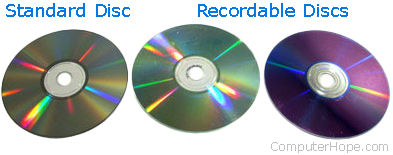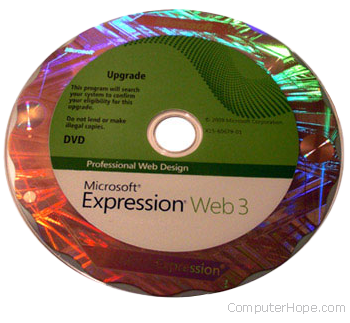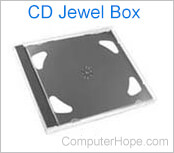How to tell if a CD or DVD is fake
When buying software online, it's important to know if you're purchasing a legitimate copy of the program or game. Below are some steps that can be taken to help identify fake CDs (compact disc) and DVDs (digital versatile disc).
Look at the bottom of the disc
One of the most common and easiest ways is to look at the bottom of the disc. Recordable discs have a green, purple, or color of tint to them, unlike the traditional CD and DVD. When CDs and DVDs are made in the factor the data on them is stamped onto the disc and not burned.

Look at the label
Another easy method of identifying a fake CD from the real thing is to look at the label of the disc. If the disc label is handwritten with a marker or printed from an inkjet printer, it's a fake CD or DVD. Unfortunately, many individuals are becoming more sophisticated and are now capable of matching labels that are identical to the real label. To help prevent easy duplication companies such as Microsoft have created more sophisticated CD and DVD labels. Below is a picture of one of these discs, which as you can see has a hologram type border. All the Microsoft discs today looks similar to the example below.

Some try duplicating this look by photo copying this label onto a sticker and use it as a label on the disc. Of course, when rotating the disc in your hand, you can see that this is not a hologram. Others may use a holographic sticker to make it appear legitimate. However, these too can be identified when looking at the edge of the disc to see if it can be peeled away.
Actual examples of pirated software seized by Microsoft can also be seen on their Microsoft how to tell page.
What the CD or DVD case looks like

If the CD or DVD is in a standard disc jewel box like the one pictured to the right, it's usually fake. In some situations, when buying a disc second hand the seller can claim they lost the original case, which may be true, but treat it as a red flag. All audio CDs and many programs and games should also have a glossy insert in the case.
Software marked as OEM or NFR
Software discs that are marked as OEM (original equipment manufacturer) are created to be included with new computers or a new motherboard. Discs also labeled as NFR (not for resale) are discs also often included with a new computer. Both discs should not be purchased by themselves as they could be an evaluation copy not designed for your computer.
Price too good to be true
If the price seems too good to be true, it probably is. For example, if you find a copy of Adobe Photoshop, a program that often costs several hundred dollars for fifty dollars it's fake. Although it may be tempting to purchase this program because it is so cheap, consider the dangers of buying and installing pirated software.
